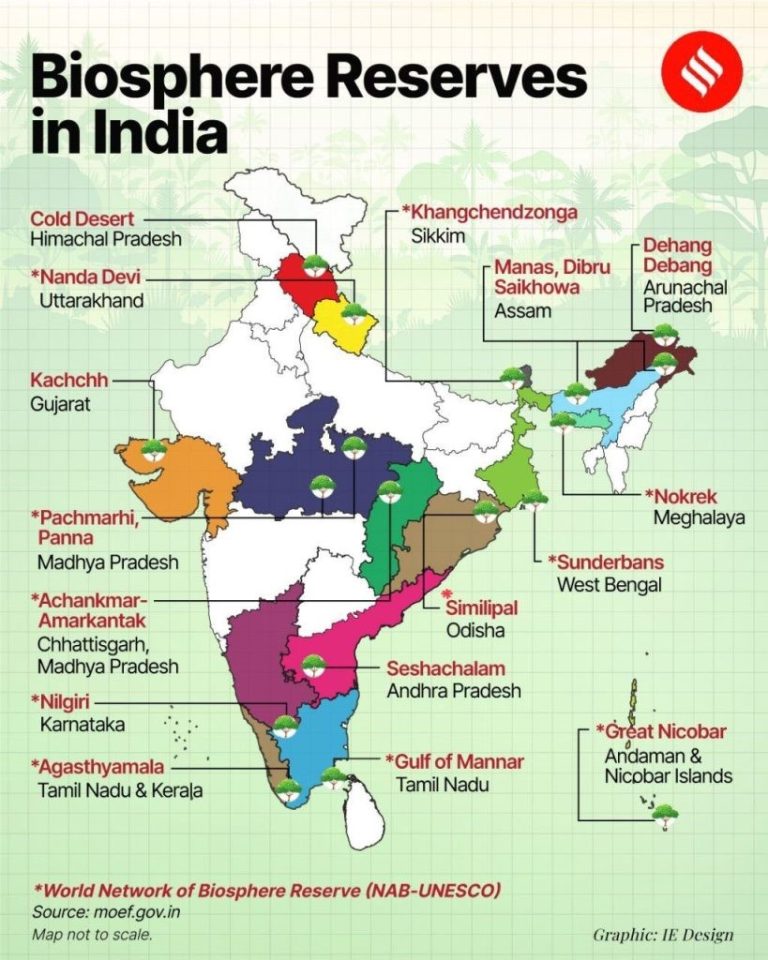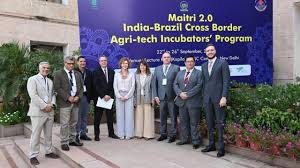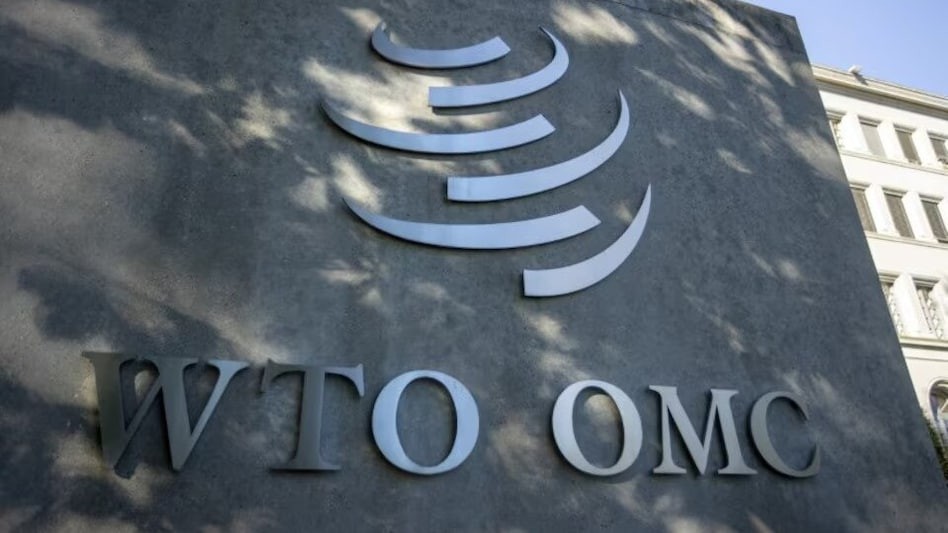UNESCO’s World Network of Biosphere Reserves

- 02 Oct 2025
In News:
UNESCO has included India’s Cold Desert Biosphere Reserve, located in Lahaul-Spiti district of Himachal Pradesh, in its World Network of Biosphere Reserves (WNBR) during the 37th ICC–MAB session (2025). This recognition makes it India’s first high-altitude cold desert biosphere reserve to join the global network, highlighting the country’s commitment to sustainable mountain ecosystem management.
About the Cold Desert Biosphere Reserve
- Established: 2009
- Location: Western Himalayas, Trans-Himalayan region of Himachal Pradesh
- Area: 7,770 sq. km
- Altitude: 3,300–6,600 m
- Constituent Areas:Pin Valley National Park, Kibber Wildlife Sanctuary, Chandratal Wetland, and adjoining regions.
- Terrain: Windswept plateaus, glacial valleys, alpine lakes, and high-altitude deserts.
- Zonation:
- Core Zone – 2,665 sq. km
- Buffer Zone – 3,977 sq. km
- Transition Zone – 1,128 sq. km
Biodiversity and Communities
- Flora: 655 herbs, 41 shrubs, and 17 tree species, including 14 endemic and 47 medicinal plants vital for the Sowa Rigpa (Amchi) traditional healing system.
- Fauna: 17 mammal and 119 bird species, including Snow Leopard, Tibetan Antelope, Himalayan Wolf, and Himalayan Ibex.
- Communities: Around 12,000 residents dependent on pastoralism, yak/goat herding, and high-altitude farming (barley and peas).
Maitri 2.0 Cross-Incubation Programme

- 02 Oct 2025
In News:
The Indian Council of Agricultural Research (ICAR) recently launched the second edition of the Brazil–India Cross-Incubation Programme in Agritech (Maitri 2.0) in New Delhi. The initiative brings together innovators, startups, and research institutions from both countries to strengthen bilateral cooperation and build a more resilient and inclusive agri-food ecosystem.
About Maitri 2.0:
- Two-Way Learning Platform: Facilitates co-creation between Indian and Brazilian innovators, enabling mutual exchange of knowledge, best practices, and technology solutions.
- Objectives:
- Strengthen incubator linkages between India and Brazil.
- Promote co-incubation models and innovation-driven collaboration.
- Open opportunities in sustainable agriculture, digital technologies, and agri-value chain development.
- Foster inclusive ecosystems that directly benefit farmers and support global food security.
Strategic Significance:
Maitri 2.0 reflects the broader India–Brazil strategic partnership, aligning with their shared vision in agriculture, emerging technologies, and food and nutritional security. It builds on historical collaborations and complements global platforms such as BRICS and G20, highlighting both nations’ roles in addressing food security and climate-resilient agriculture.
Radar-Mounted Drones for Surveillance
- 02 Oct 2025
In News:
The Border Security Force (BSF), India’s first line of defence, is collaborating with the Indian Space Research Organisation (ISRO) to develop radar-mounted drones aimed at enhancing surveillance along India’s western and eastern borders. This initiative seeks to strengthen border security by providing persistent, high-accuracy monitoring of remote and difficult terrains without crossing international boundaries.
About Radar-Mounted Drones:
- Technology: Unmanned aerial systems equipped with compact radars capable of detecting moving targets, vehicles, or intruders.
- All-Weather Capability: Operates effectively in fog, darkness, rain, or adverse weather, unlike visual-only sensors.
- Real-Time Alerts: Provides immediate notifications, enabling rapid deployment of troops and timely response to border threats.
- Integrated Sensor Fusion: Potential to combine radar with infrared, high-resolution cameras, and ground sensors for enhanced detection.
- High Mobility and Scalability: Drones can be rapidly deployed in inaccessible areas, and multiple units can cover larger regions during crises.
Significance:
- The system is designed to overcome limitations of conventional border guarding, which relies on mobile soldiers or fixed towers and is effective only in limited areas.
- Radar-equipped drones can provide continuous day-and-night surveillance, monitor regions where permanent radars or outposts cannot be installed, and assist in controlling smuggling or infiltration attempts.
- The BSF, drawing experience from operations like ‘Operation Sindoor’, has also established a School of Drone Warfare at its Tekanpur Academy in Madhya Pradesh. In the coming months, the force plans to manufacture these radar-equipped drones in-house, further enhancing India’s technological edge in border security.
- This initiative exemplifies the growing role of technological interventions in modern border management, ensuring vigilance, rapid response, and comprehensive monitoring of India’s frontier regions.
Siphon-Powered Desalination
- 02 Oct 2025
In News:
- Researchers at the Indian Institute of Science (IISc), Bengaluru, have developed an innovative siphon-powered thermal desalination system that can transform seawater into potable water faster, cheaper, and more reliably than existing technologies.
- The breakthrough addresses long-standing challenges in solar desalination, such as salt buildup and limited wicking height, offering a scalable solution for water-stressed regions.
How the Siphon-Powered System Works:
- Composite Siphon: A fabric wick paired with a grooved metal surface continuously draws seawater from a reservoir.
- Gravity Flow: Ensures smooth movement and flushes away salt before crystallization occurs.
- Thin-Film Evaporation: Water spreads as a thin layer on heated metal surfaces and evaporates efficiently.
- Ultra-Narrow Air Gap: Vapor condenses just 2 mm away on a cooler surface, enhancing efficiency.
- Multistage Stacking: Multiple evaporator–condenser pairs recycle heat, maximizing water output.
Key Features and Advantages:
- High Efficiency: Produces more than 6 litres of potable water per square metre per hour under sunlight, significantly higher than conventional solar stills.
- Low-Cost Materials: Uses aluminum and fabric, making it affordable and easy to deploy.
- Energy Flexibility: Operates on solar energy or waste heat, enabling off-grid functionality.
- Durability: Can handle highly saline water (up to 20% salt) without clogging.
- Scalability: Suitable for villages, coastal areas, disaster zones, and island nations.
Significance:
- Water Security: Provides a sustainable solution for drinking water scarcity in remote and off-grid regions.
- Innovation Leap: Overcomes technical limits of traditional solar stills, particularly salt scaling and wicking height.
- Sustainable Development: Eco-friendly, low-cost, and aligned with SDG 6 (Clean Water and Sanitation).
Supported by India’s Department of Science and Technology (DST) and published in Desalination, this technology could make the ocean a reliable source of fresh water for millions, emphasizing simplicity, salt resistance, and scalability as its core strengths.
Special and Differential Treatment (SDT)

- 02 Oct 2025
In News:
China has announced that it will continue to be classified as a developing country within the World Trade Organization (WTO) but will no longer seek Special and Differential Treatment (S&DT) in future negotiations.
About Special and Differential Treatment (S&DT):
- S&DT grants developing and least-developed countries (LDCs) flexibilities in implementing WTO obligations, including longer deadlines, preferential market access, safeguard measures, and technical assistance.
- Introduced under GATT in the 1960s and formalized in WTO agreements (1995) and the Doha Development Agenda (2001).
- LDCs receive additional automatic benefits; other countries self-declare their status, subject to challenge by WTO members.
Significance of China’s Decision:
- China, historically a major beneficiary of S&DT, will forego such benefits while retaining its developing country status.
- The move signals support for multilateral trade and contributes to WTO reform, addressing concerns raised by the United States and others over selective access to S&DT.
- It highlights the tension between economic capabilities and self-declared developing status, especially among major economies.
Implications:
- Encourages balanced WTO negotiations and strengthens the global trading system.
- Marks a step towards aligning development considerations with global economic realities without relinquishing China’s role in the Global South.
